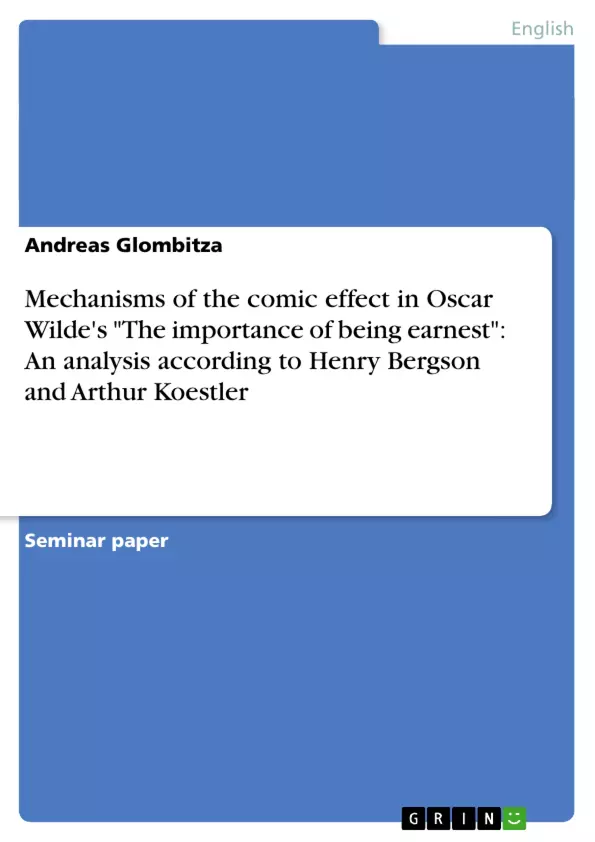Oscar Wilde′s "The Importance of Being Earnest" was on stage for the first time in 1895. Since then, it seems to have lost nothing of its wit. People still consider it funny, when Algernon and Jack, both alias Ernest, bend the truth to jazz up their lives, ending up with seri-ous problems. But what is it actually that made, that still makes Wilde′s play funny? What is the connection between a certain reply from Algernon or Lady Bracknell and the audience or reader trem-bling with laughter (or at least smiling)? This paper will be concerned with the question whether it is possible to trace all of Wilde′s comical devices, perhaps even all possible forms of humour, back to one basic "recipe of laughter".
People tried to do this, although the matter seems to be extremely complicated. Who has not yet experienced the embarrassment, while trying to explain a pun or joke to somebody who did not get it on the first time: the comical element slips through your fingers like water and soon seems to have never existed, although it has caused audible and visible effect, namely laughter, a moment before. We will start from what the philosopher Henry Bergson found out about mechanisms of the comic effect and see if his theory accounts for Wilde′s play being comical. Later I want to outline the theory of bisociation, which Arthur Koestler brought up, and finally analyze the play along the lines of the theoretical apparatus he developed. Throughout the second chapter I will show that both theories will break down if confronted with certain forms of the comic element.
Inhaltsverzeichnis (Table of Contents)
- Introduction
- Mechanisms of the comic effect
- An overview of Henry Bergson's theory of laughter
- Bergsonian patterns of humour in Wilde's play
- The basic ideas of Koestler's bisociative approach to the comic effect
- Bisociative patterns in Wilde's text
- Conclusion
Zielsetzung und Themenschwerpunkte (Objectives and Key Themes)
This paper aims to analyze the comedic effects in Oscar Wilde's play “The Importance of Being Earnest” through the lenses of two prominent theories of humor: Henry Bergson's theory of laughter and Arthur Koestler's bisociative approach. It explores the possibility of tracing all comedic devices in Wilde's work back to a single underlying principle.
- The nature of humor and its mechanisms
- Bergson's theory of laughter and its applicability to Wilde's play
- Koestler's bisociative theory of humor and its application to Wilde's play
- The limitations of both theories in explaining all forms of humor in Wilde's work
- The role of social and societal aspects in the creation of humor
Zusammenfassung der Kapitel (Chapter Summaries)
- Introduction: This chapter introduces the topic of comedic effect in Oscar Wilde's “The Importance of Being Earnest,” highlighting the play's enduring humor and posing the question of a unifying principle behind its comedic devices.
- Mechanisms of the comic effect: This section examines Bergson's theory of laughter, outlining its central ideas and analyzing its applicability to Wilde's play. It explores Bergson's concept of laughter as a social corrective for “inelasticity” and rigidity in human behavior, discussing the three main comic effects he identifies: disguise, mechanical repetition, and involuntary gesture.
- An overview of Henry Bergson's theory of laughter: This chapter delves into Bergson's theory of laughter, exploring his central claims about the nature of the comic, including its connection to human behavior, the requirement of “absence of feeling,” and the social significance of laughter.
- Bergsonian patterns of humour in Wilde's play: This chapter analyzes Wilde's play in light of Bergson's theory of laughter, examining the presence of Bergsonian patterns such as disguise, mechanical repetition, and involuntary gesture in the play's humor.
Schlüsselwörter (Keywords)
The main keywords and focus topics of the text include comedic effect, Oscar Wilde, “The Importance of Being Earnest,” Henry Bergson, theory of laughter, Arthur Koestler, bisociation, social significance of humor, disguise, mechanical repetition, involuntary gesture, and literary analysis.
- Quote paper
- Andreas Glombitza (Author), 2003, Mechanisms of the comic effect in Oscar Wilde's "The importance of being earnest": An analysis according to Henry Bergson and Arthur Koestler, Munich, GRIN Verlag, https://www.grin.com/document/20900



